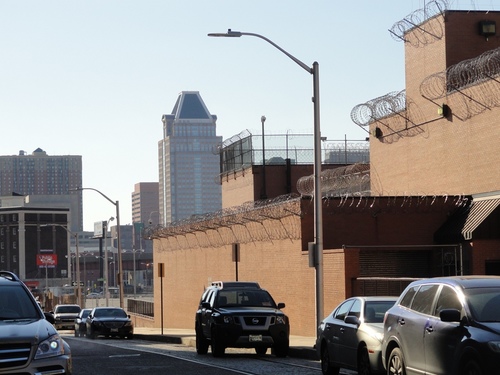To boost downtown Baltimore, get rid of its downtown jail
Baltimore’s downtown jail is a source of blight and a physical barrier between the city center and some of its most impoverished neighborhoods. Could moving it help heal the city?
The city’s existing penal facility is a forbidding, sprawling 27-acre campus between the Johns Hopkins Medical Campus (JHMC) and downtown. It consumes vast amount of acreage on potentially lucrative real estate. Surface parking, blight, bail bonds, and strip clubs are the jail’s only neighbors.
Most cities have sensibly relocated their prisons away from their economic centers. Moving Baltimore’s jail from downtown was a pie-in-the-sky idea until Maryland began planning to sink over $500 million into demolishing and rebuilding the jail in place. Instead, what if the state spent the money to move the jail out of downtown entirely, freeing up the land for more constructive uses?
City Marketing 101 says you shouldn’t put your jail as the welcome mat to your downtown or your top research hospital. By doing so, Baltimore sends the thousands of people coming to visit, to work, or to invest a grim reminder that the city immortalized by “The Wire” houses lots of dangerous people.
The jail’s current location may be convenient for visitors and employees. It’s transit-accessible, and the criminal courts are nearby. But if you consider the land’s far greater potential, relocating the jail to Jessup, home to several other prisons, or abandoned industrial zones are better options.
Moving the jail presents Baltimore with many opportunities. Opening up space between downtown and Hopkins, the nation’s #1 hospital, could create synergy between the hospital and area businesses, or drive investment to Jones Town, the long-stalled redevelopment of Old Town Mall, or the array of surface parking littered about. Some land could even become a park to serve downtown residents.
Meanwhile, the surrounding property would be more attractive to investment without a prison to repel more promising development. And in any scenario, redevelopment could generate jobs for the city, while retaining existing prison jobs elsewhere. Portions of new revenues from development could support other investments, like jobs for youth.
We should be cautious about building costly new prisons. America must find a way to reduce its world leading incarceration rates, while preventing violent crime. Locally, Baltimore’s recent prison issues are certainly as much about management as with the aging physical facility.
Improved training and wages for prison guards and personnel would be astronomically cheaper than constructing new facilities. However, at some point, new facilities are going to be built. Good money should not be spent on a misplaced location.
Relocating large prison facilities from downtown is not only not unprecedented, it is common. New York City’s main prison is an island in the East River. Indianapolis mayor Greg Ballard is now leading a plan to relocate its jail out of downtown. Aaron Renn explains how doing so could be a “game-changer” by eliminating multiple barriers to redevelopment.
Maryland is projected to add a million people by 2040. Baltimore needs to position itself to capture a portion of this growth. Adding dozens of acres available for development adjacent to the city’s most prominent employers, as well as I-83 and the subway, is a promising opportunity.
The Department of Corrections is only looking at ways to build a new jail, but that shouldn’t limit the thinking of top decision-makers in Baltimore and at the state level. There are innovative ways to reduce incarceration, provide opportunity, and remove barriers to Baltimore’s economic potential. Rebuilding the jail in place should not be a rubber stamp. If other cities understand this, Baltimore should too!
Crossposted at Comeback City.



